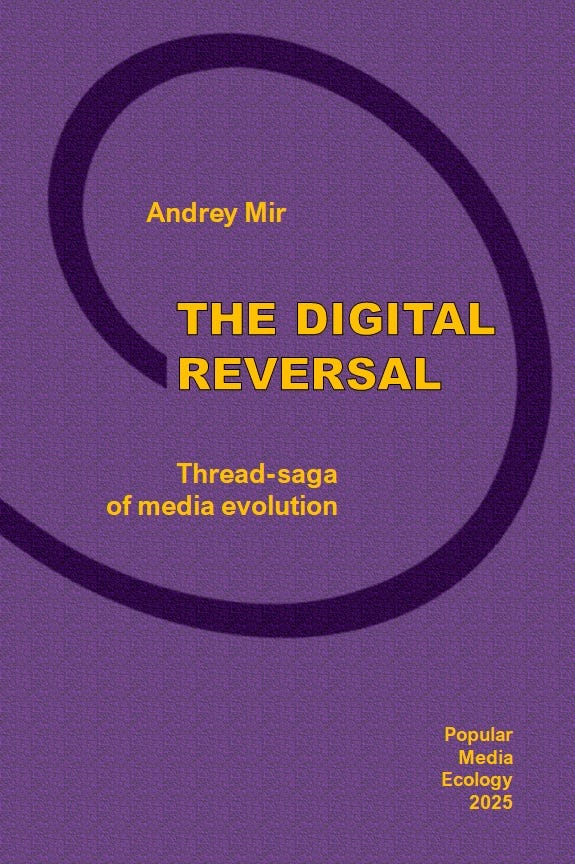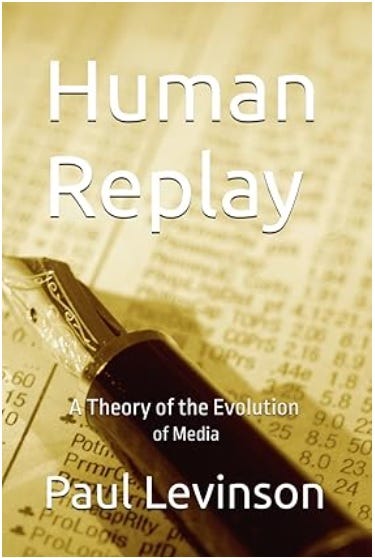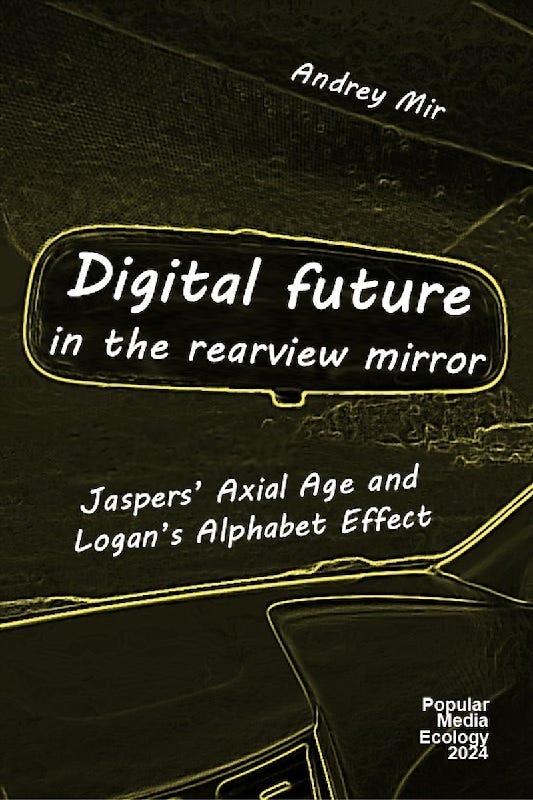If media evolve to replay human functions, what will be the ultimate form of Human Replay?
A debate on the fate of humankind
According to McLuhan, media extend human physical or mental faculties—but what are the ultimate limits of this extension? And what happens to humankind when media reach the full potential of this extension?
In The Digital Reversal, I used Paul Levinson’s concept of human replay to describe the ultimate, final reversal of humankind—the reversal of media replaying humans into replacing them. In his review, Paul disagreed with the twist:
Mir writes, “humans themselves are becoming digital—so far just metaphorically, but soon literally, and not in the literate sense of the word.” Not just metaphorically? Meaning, what? That sometime around 2050, if I live that long, my blood cells, my brain, my DNA, or whatever will literally turn into some kind of digital code, which will replace my self-awareness?
I’d like to elaborate on this. What does the reversal of replaying into replacing humans by media mean?
First, here is a summary of Levinson’s idea of human replay, as I put it in The Digital Reversal (the entire book is written in tweets, hence short paragraphs, no more than 280 characters each).
In 1978, Paul Levinson introduced the “anthropotropic” theory of media evolution, which holds that media evolve to better accommodate human natural capacities. In the 1970s, instant replay on sports TV was a thing, so he titled his study Human Replay[i]—a very rich metaphor.
Mediating the environment, technologies must be compatible with what humans do or can do. They must “replicate” the natural modes of human sensorial and mental operation—hence the term “anthropotropic,” meaning “turning toward humans.”
At stage A of media evolution, Levinson posits, media extended humans in the physical world while preserving natural face-to-face interaction. I call these Promethean media: fire and implements. They made humans the most powerful species—still within nature and its limits.
At stage B, technologies overcame biological restraints and extended humans beyond physical reach—but at the cost of the sensorium’s integrity. Literacy disturbed the natural balance of senses and isolated vision, enabling focus and detachment. Humans conquered the planet.
Finally, at stage C, media preserve their capacities to overcome space and time but seek to retrieve the holistic sensory perception, as in face-to-face interaction. This becomes possible in a different reality—in a reality induced by electronic and now digital media.
Levinson compares early technology to the forbidden fruit of knowledge “that at first extended us out of the natural Garden of Eden.” At stage C, he says, media become “a remarkable fruit that permits us re-entry.”[ii] We’re getting immersive extension—but the Garden is digital.
Levinson developed his theory in the late TV era, seeing the most advanced replication of pre-technological sensorial mode in holography. His idea of “human replay” is fully unfolding in digital reality. [iii] Our digital personas replay us in interactions with others and the world.
<…>
To extend Levinson’s idea of “human replay”[iv]: digital media offered us a nearly perfect replay of the entire human persona in our image and after our likeness—but then reversed human replaying into human replacing, as media always do to the human organs or faculties they extend.
The reversal of human replaying into human replacing is an inevitable side effect of the reversal of explosion into implosion, when the mediated environment gets suddenly squeezed into not just the user’s perception but the user’s interaction—when interaction becomes environment.
Since media are extensions of humans, media evolution exploded humankind into the world. The final stage of this extension—the Singularity—will be the last reversal: it will implode the world into humankind, when humankind, its medium, and its environment become one.
So, what did I mean by saying “humans themselves are becoming digital—so far just metaphorically, but soon literally, and not in the literate sense of the word”? Will it be a Terminator who, as Paul playfully suggested on another occasion, will come and say, “I need your clothes, your boots and your motorcycle”? Hopefully not. (Though, who knows!)
I am not interested in predicting the practical circumstances of this final reversal. The details of the future cannot be foreseen from the present, as our (my) technological knowledge is simply insufficient for that—and Paul is correct in pointing this out. But I am sure the tech people are relentlessly working on it. They will figure out which green wire to fasten to which red wire. Or, more likely, AI will figure it out.
Anyone familiar with the concept of accelerated time understands that the amount of knowledge produced per unit of time grows exponentially. Metaphorically speaking, 10% of the knowledge required for the final reversal of humankind, otherwise known as Singularity, has been accumulated over thousands of years of human history, and the remaining 90% will be generated in the last microseconds before the Event, when the exponential curve goes vertical.
Let’s look not at the details we don’t know and can’t know, but at the logic of human replay—a very insightful and powerful media-ecological metaphor.
According to McLuhan’s four laws of media, the famous Tetrad (enhancement, obsolescence, retrieval, and reversal), any medium, idea, artefact, or technology, when reaching its limits, extremes, or full potential, reverses into its opposite or reverses its effects into the opposite.
Media evolve to replay human faculties. First, they extended (or replayed, in Levinson’s words) different isolated faculties, while distorting the natural human sensorium. What is extended is also “numbed,” or even “amputated,” according to McLuhan. This embodies the idea of reversal: when a medium is effective in extending a human faculty and reaches its full potential, it reverses our use of this natural faculty into “non-use.”
For example, writing extended our natural memory but also “numbed” and “amputated” exactly that part of our organic memory that was extended. We no longer remember phone numbers or birthdays—but this is because media (smartphone) have extended our memory and replayed this function for us. So human replay does lead to replacement.
We were mostly okay with media replaying and replacing specific functions but cannot accept the idea of total human replay and replacement. In the meantime, I just took the logic of Levinson’s insight to its farthest possible point, to its extreme, to its limits, to its full potential—the condition of McLuhan’s reversal.
Indeed, if media evolve by replaying humans, what does this evolution lead to? In his three stages of media evolution, Levinson clearly describes the growing success of media in replaying humans more and more coherently, “holistically,” and seamlessly, leading to replaying the entire sensorium, not just isolated functions. In the 1970s, when Paul pondered this idea, the closest approximation for a holistic human replay was the hologram. Now we know that holistic perception is best replayed in virtual reality, but also by a social media persona, and now by a large language model—generative AI, which replays the language of the entire humankind.
Media replay us in the environment—or the environments for us—in an increasingly natural-like fashion. What will be the ultimate form of human replay? In McLuhan’s logic: what does ultimate human replay reverse? Into what?
This logic dictates: Human replay, reaching its ultimate form, must reverse into human replacement.
How will it happen in practical terms? The machine uprising? The self-awakening of our newest and most advanced medium that reaches the ultimate form of replaying (and replacing) humankind, as in the Skynet–Terminator scenario? The upload and merger of the human mind with the machine? Those options are on the table: sci-fi can be very insightful in areas that we cannot grasp with our current technical development, as it limits our understanding.
But guessing such details is a distraction, especially when guessing from the perspective of a person waiting to experience it: “How will it happen to me specifically?” It likely will not. Evolution is not concerned with individuals, nor is it kind to them; evolution literally proceeds by individuals dying out. Evolution is always about a species. And so is media evolution.
In the ultimate human replay, the ultimate medium will replay humankind, not a specific person. (Though there are scenarios in which the ultimate reversal may happen to a specific person who successfully completes the mind upload and will “represent” the entire humankind at the moment of the final reversal. Watch Musk and his Neuralink, and watch it much more closely than his SpaceX or X. SpaceX will lose the media-extension race to Neuralink. Humankind will ultimately extend into digital, not outer, space.)
Another common point of objection is machines’ lack of intentionality and agency. But this is, again, today’s objection to tomorrow’s development. Moreover, this is an unjustifiable anthropomorphizing of evolution. The lack of intent or agency in the machine can be supplanted by the technological imperative (see: The reversal of human agency: The technological imperative), a concept that plays very well with Levinson’s idea of human replay. The technological imperative drives any technology to perfect its performance and reach its full potential—regardless of human will or even resistance. Humans just facilitate this process in exchange for the conveniences media evolution provides.
What happens when media evolution approaches the logical limits of human extension and human replay? We can easily determine the key characteristic of this ultimate extension: the full extension is an extension of the user and the medium to the full extent of their environment. The user, the medium, and the environment become one. Extension reverses into implosion.
AI has already been nearing these conditions: as a medium, generative AI has become an environment to itself. All that remains is incorporating the user as well (or becoming the self-user, which is the same).
Essentially, the technological imperative is the invisible hand of media evolution that drives it toward the full potential of human replay, which is also the condition of reversal. The final reversal of humankind is embedded in the logic of media evolution.
Contours of the future are fuzzy. They are especially distracting when we look for details, not patterns. One cannot recognize the Eiffel Tower by looking closely at nuts and bolts, but the silhouette of the Eiffel Tower is recognizable in any fog if you look for the pattern. Media ecology is the pattern recognition in the evolutionary logic of media.
Where does the logic of media evolution lead us? What is the ultimate medium, reaching the ultimate extension of the user in space and time? To what ultimate reversal does this ultimate medium lead when reaching its full potential? If media are to replay humans, what is the ultimate human replay?
…This is what good insight does. It detaches from the author and dictates its own logic. Paul Levinson unleashed the metaphor of human replay almost 50 years ago, for it to reemerge in the era of AI and provoke further wild speculations about the fate of humankind.
(Paul will likely respond—stay tuned.)
PS. An unrelated story. In the global media ecological community, there are two factions: Postmaniacs and McLuhanatics, as I call them, based respectively in New York (and the rest of the world) and Toronto (and the rest of the world). But Paul Levinson was a doctoral student of Postman and collaborated with McLuhan. He was a guest in the McLuhan home and can tell tons of anecdotes. Paul even has a voicemail recording from McLuhan, I believe the only one in the world. Check it out, it’s a short and funny story: Voice Mail from Marshall McLuhan, 1978.
See also books by Andrey Mir:
The Viral Inquisitor and other essays on postjournalism and media ecology (2024)
Digital Future in the Rearview Mirror: Jaspers’ Axial Age and Logan’s Alphabet Effect (2024)
[i] Levinson, Paul. (2017). Human Replay: A Theory of the Evolution of Media. Originally conceived as a PhD dissertation in 1978 under the supervision of Neil Postman, it was likely the first evolutionary theory of media. See also my review: “Media evolution—the evolution of what? Thoughts on the margins of Paul Levinson’s Human Replay.”
[ii] Levinson, Paul. (2017). Human Replay: A Theory of the Evolution of Media. P. 24.
[iii] I like an extended reading of Levinson’s rich concept of “human replay”—media replay not just human activities but now humans themselves. I also want to take this moment to thank Paul for his support and the many fruitful conversations we’ve had online and in person, especially during our almost annual “summer summits” on Cape Cod.
[iv] Levinson, Paul. (2017). Human Replay: A Theory of the Evolution of Media.






